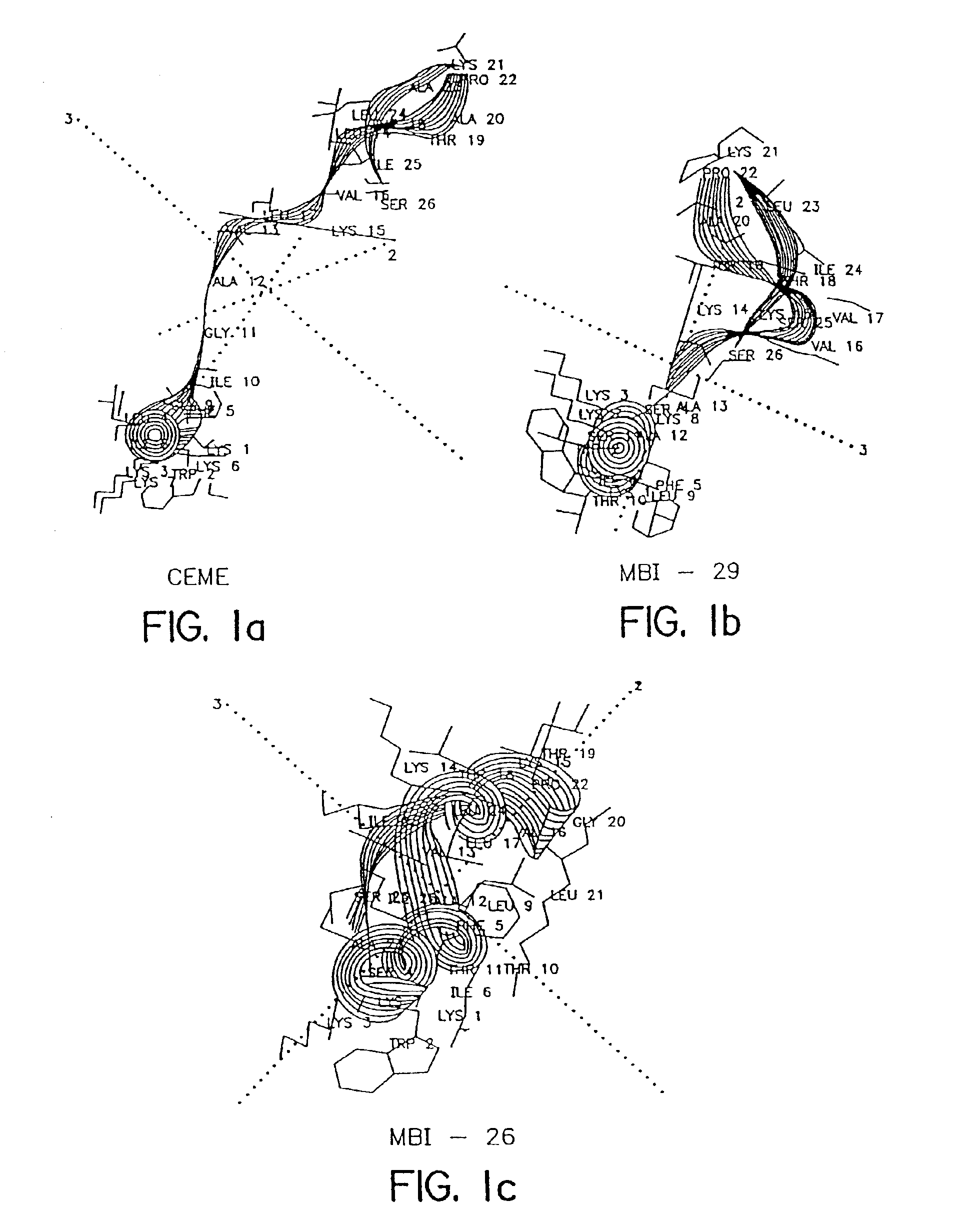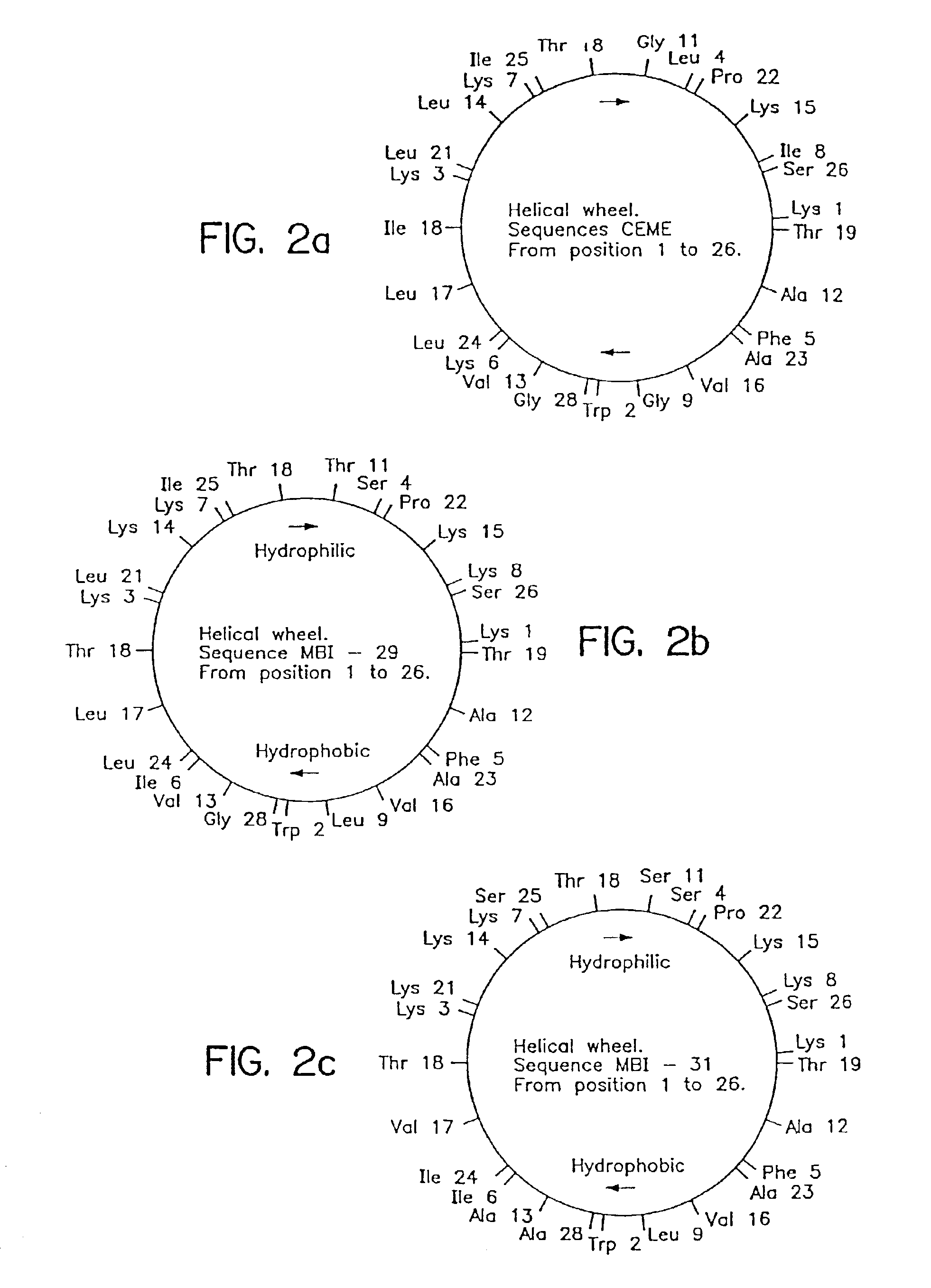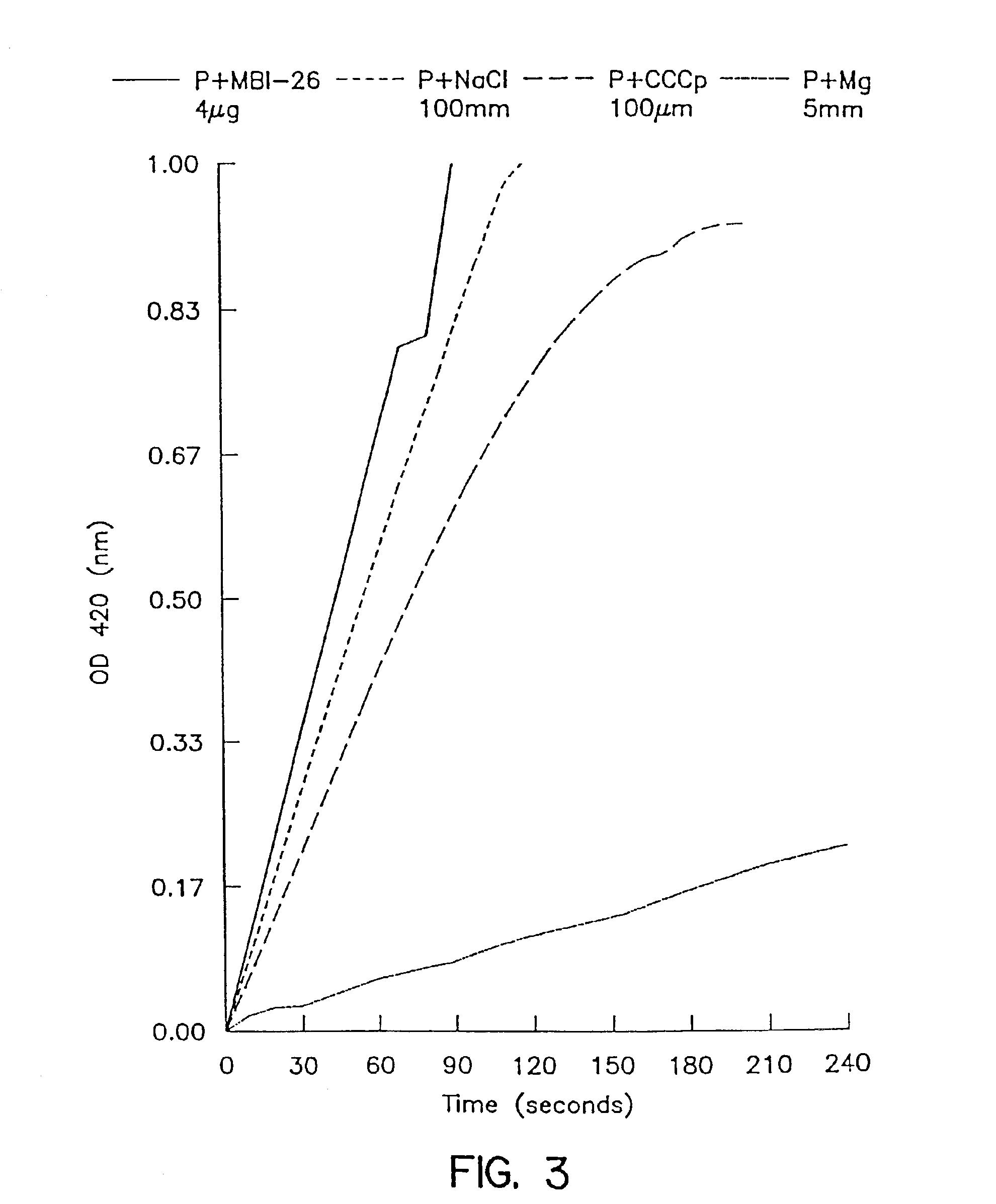Antimicrobial cationic peptides
a cationic peptide, antimicrobial technology, applied in the direction of peptide/protein ingredients, peptide sources, applications, etc., can solve the problems of limited amount of these peptides that can be isolated, defensin has been cloned, and no successful expression has been demonstrated
- Summary
- Abstract
- Description
- Claims
- Application Information
AI Technical Summary
Benefits of technology
Problems solved by technology
Method used
Image
Examples
example 1
MIC Values for Catonic Peptides
[0071]The minimum inhibitory concentrations of (MIC) of CEME, CEMA, the first 8 amino acid residues of CEME KWKLFKKIGIGAVLKVLTTGLPALIS; SEQ ID NO:1 with changes at residues 4, 6, 8-11, 14) and CEMA KWKLFKKJGIGAVLTTGLPALIS; SEQ ID NO:1 with changes at residues 4, 6, 8, 11, 14, and 25-28), (Piers, K. and Hancock, R., Molec. Microbiology, 12(6) 1994) 20 carboxy terminal amino acids of melittin (MA), 8 amino terminal amino acids from 25 cecropin, and the peptides shown in SEQ ID NO:1, MBI 29 and SEQ ID NO:2, MBI 26, were determined for a number of different bacteria (Table 1a and 1b). Briefly, cells were grown overnight at 37° C. in LB-S (Luria broth without any salt supplement) and diluted one in 10,000 in the same medium to give concentrations of about 104 to 105 CFU / ml. The broth dilutions were set up in a 96 well microtiter plate by putting 200 μl of LB-S containing the initial concentration of antibiotic or compound in column 1 and 100 μl of the same ...
example 2
Effect of Formulation on Bactericidal Activity
[0103]Effect of formulation on bactericidal activity and MIC was determined using the test solutions listed below. The results show that citrate and related formulations reduced the MIC (Table 2). Similar effects were seen with acetate formulated peptide (Tables 2 and 3).
[0104]
TABLE 2 EFFECT OF CITRATE, ASCORBIC ACID AND DEXTROSE ON MBI 26 (10 MG / ML) KILLING OF P. AERUGINOSASurvivors at Time (min.)Test SolutionPeptide0153060CitrateControl1.1 × 107 1.1 × 1071.2 × 1071.4 × 107(0.129 M)+MBI 261.1 × 107 000CitrateControl1.3 × 107 1.2 × 1071.7 × 1071.7 × 107(0.129 M)+Ascorbic+MBI 261.3 × 107 000Acid(100 mM)Citrate-Control1.2 × 107 5.8 × 1066.9 × 106Dextrose+MBI26 9 × 1062000Citrate-Control7.8 × 106 65 × 1071.5 × 1071.1 × 107PhosphateDextrose+MBI 26000DextranControl2.3 × 1072.2 × 1071.4 × 107 2 × 107+MBI 261.9 × 107 1.2 × 106 1 × 1068.5 × 105(20 μg)
[0105]
TABLE 3EFFECT OF CITRATE ADDITION TO CATION ADJUSTED MEDIAON MINIMAL INHIBITOR...
example 3
Inner Membrane Permeabilization
[0107]Inner membrane permeability was determined by measurement in E. coli ML 35 of β-galactosidase activity using ONPG as a substrate. Normally ONPG cannot pass across the cytoplasmic membrane to permit hydrolysis by the cytoplasmic enzyme β-galactosidase. However, cationic peptides, by permeabilizing the inner membrane, unmasks this enzyme leading to color development as ONP is released. MBI 26 and MBI 29 were tested with the same conditions as shown in FIGS. 3 and 4 (4 ug MBI 26 or MBI 29 alone, ▬; +100 mM NaCl, □; +100 uM CCCP, ; +5 mM Mg, ▬▪▪▬). While 100 mM NaCl had little effect on MBI 26 permeabilization, 5 mM Mg++ had a large inhibitory effect. MBI 29 permeabilization of the inner membrane was the least affected by any of the conditions especially Mg++ as seen in FIG. 4. Addition of citrate increased the lag time before the peptides were able to permeabilize the membranes. When the experiments were executed in cation adjusted media (CAMHB), th...
PUM
| Property | Measurement | Unit |
|---|---|---|
| Fraction | aaaaa | aaaaa |
| Temperature | aaaaa | aaaaa |
| Volume | aaaaa | aaaaa |
Abstract
Description
Claims
Application Information
 Login to View More
Login to View More - R&D
- Intellectual Property
- Life Sciences
- Materials
- Tech Scout
- Unparalleled Data Quality
- Higher Quality Content
- 60% Fewer Hallucinations
Browse by: Latest US Patents, China's latest patents, Technical Efficacy Thesaurus, Application Domain, Technology Topic, Popular Technical Reports.
© 2025 PatSnap. All rights reserved.Legal|Privacy policy|Modern Slavery Act Transparency Statement|Sitemap|About US| Contact US: help@patsnap.com



